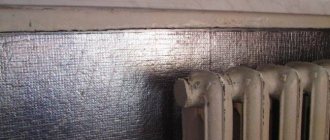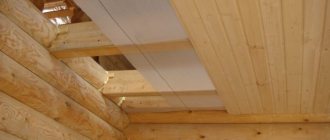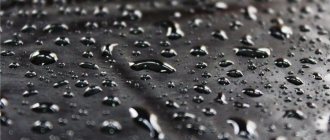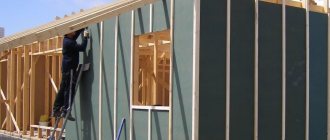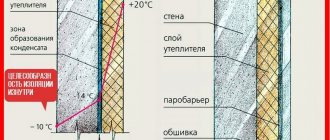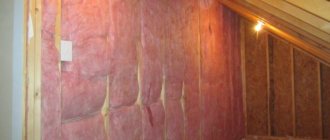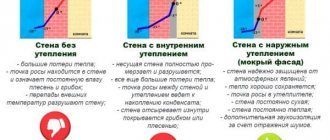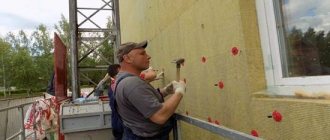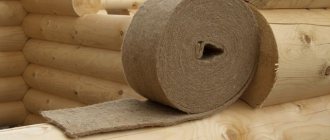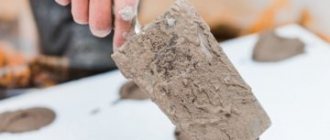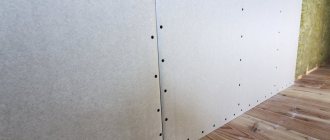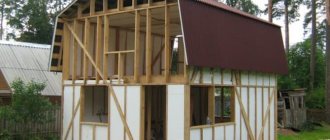Why is vapor barrier necessary?
For the walls of a wooden house, a layer of vapor barrier (also called waterproofing) is necessary in almost all cases. The reason is in the characteristics of wood as a building material: it allows air to pass through well, but at the same time absorbs a lot of moisture, which is why it swells. If timely measures are not taken, this can lead to negative consequences:
- the walls will begin to curve or heave;
- the structure of the house will inevitably begin to sag due to increased wood density;
- finishing materials (lining, drywall and others), as well as wall coverings (wallpaper, MDF, PVC) can be damaged due to wall movement;
- mold may grow in the thickness of the walls and corners, which will create an unpleasant odor in the house;
- if water freezes during the winter cold, it will increase in volume, which will cause cracks and microcracks in the wood to increase, and the material will wear out faster;
- an increase in cracks also has another negative effect - over the years, the walls will freeze much faster, which is why you have to spend more resources on heating the room;
- finally, when moisture is absorbed into the insulation material, this quickly leads to its softening and deterioration - eventually you will have to dismantle the wall and install a new layer.
All these consequences can be easily avoided if, after completion of construction, a vapor barrier layer is laid, which follows immediately after the finishing material (for example, lining) and is tightly adjacent to the insulation, as shown in the diagram.
NOTE. Sometimes a vapor barrier layer is understood as a material that does not allow moisture to pass through, but allows air to pass through, and waterproofing is a material that does not allow either water or air to pass through. In a practical sense, the words are often used as two synonyms.
Features of vapor barrier installation
Many people are interested in how to properly lay vapor barrier film. In this case, it is enough to strictly follow the instructions for performing work on various sections of the construction site.
How to lay a vapor barrier layer on walls
As a result of installing the vapor barrier film, a layer consisting of several elements should appear. The new building cake should consist of several layers:
- external cladding;
- windproofing;
- insulation layer;
- frame;
- vapor barriers;
- interior decoration.
Before you finally lay the vapor barrier, you should decide on its purpose. To ventilate the insulation, materials are installed only on internal walls. In this case, the insulator cannot be fixed on both sides of the insulation, as this will lead to the formation of condensation due to disruption of the natural insulation.
If mineral-based materials were chosen as insulation, laying a vapor barrier layer is required. It is also important how to install the vapor barrier. Compliance with the work order guarantees high quality and long service life. The process consists of several stages:
- Installing the film and securing it to the sheathing.
- Sealing formed cracks, overlaps and puncture sites.
- Installation of sheathing using beams to provide ventilation.
- Sheathing with plasterboard, panels or other finishing materials.
However, it is impossible to install vapor barriers on walls without pre-treatment.
Is it possible to do without vapor barrier walls?
This option is, in principle, possible if the walls of the house are made of rounded or laminated veneer lumber, which is thoroughly dried during production. In addition, all the dimensions of the grooves where the logs will fall are calculated to the nearest millimeters, which ensures their tightest contact with each other.
But even in such cases, it is impossible to give a firm guarantee that moisture will not penetrate the tree, since the following risks remain:
- Wood as a material has its own specifics - it is porous, fibrous, and serves as a breeding ground for the development of microorganisms.
- Protective varnish treatment works well during the first 5-10 years, but over time it tends to disappear - accordingly, after this period, moisture can gradually begin to penetrate into the wood.
- Finally, if you plan to live permanently in a wooden house, it is best to take care of a vapor barrier to protect its walls - the constant action of moisture coming from the kitchen, bath, aquarium and other household sources will make itself felt over several years.
- To house a bathhouse, a layer of vapor barrier is, for obvious reasons, necessary in any case.
If the house is located in a humid coastal climate, then waterproofing is an absolutely necessary measure: it is done both inside and outside.
Approximate calculations show that in 1 year an ordinary family consisting of 3 people (two adults and a child) releases 150 liters of moisture into the air.
Features of vapor barrier for walls of frame houses
When installing a ventilation system, insulating walls with ecowool, polystyrene foam, polyurethane foam, a vapor barrier is not necessary, but is possible according to two schemes:
- For temporary residence buildings: cottages, outbuildings, workshops, garages, guest houses. A vapor barrier membrane is attached to the frame posts, over which clapboard, plasterboard, and other finishing materials are applied;
- For permanent residence buildings: a sheathing is installed over the vapor barrier to provide a ventilation gap (30–40 mm) necessary to remove moisture into the atmosphere.
Vapor barrier materials: types, selection rules and prices
Modern industry offers many types of materials for waterproofing. Almost all of them are artificial polymers, because natural fibers always absorb moisture well and allow it to pass in both directions.
The main indicator of the quality of such products is vapor permeability, which is defined as the amount of water (in grams) that a unit of material area (1 square meter) will let through in one day: g/m2. Normal vapor permeability does not exceed 15-20 g/m2.
From the point of view of advantages and disadvantages, the material is judged on the basis of the following consumer qualities:
- life time;
- mechanical strength;
- ability to pass air, i.e. breathe while retaining moisture.
Many waterproofing materials have low air permeability, which creates a greenhouse effect in the house - you have to constantly ventilate the room, including in the cold winter.
A comparison of the pros and cons of the most common materials is presented in the table (price - in rubles for 1 roll, the total area of which is standard 70 m2). In the case of a vapor barrier membrane, the average cost is given for a roll with dimensions of 75 by 1 meter (area 75 m2).
Why do you need to install a vapor barrier inside and outside your home?
When finishing the walls of a house inside and outside, insulation materials are often used, which absorb moisture like breathable materials. As a result, a condensate collection point appears. This leads to destruction of the insulation, the appearance of fungus, deformation and damage to finishing materials (detachment of wallpaper, falling off of tiles, deformation of plasterboard sheets).
To create the desired microclimate in the room, a vapor barrier is used that can prevent moisture from reaching the insulation. At the same time, many of these components are breathable, which is necessary for both walls and finishing materials. This feature allows for ventilation, which is necessary for all elements on the walls.
Cases when vapor barrier is required:
- When the walls inside the room are insulated with mineral wool. It is breathable and breaks down when exposed to moisture.
- Walls covered with plasterboard and other cladding. Basically, condensation is created between the rough wall and the cladding, which negatively affects the finish.
- A vapor barrier layer is installed on the outside to protect the walls from external moisture. This is done when insulating the facade of a building.
Why do you need a vapor barrier?
Currently, many people who are building individual residential buildings are thinking about installing vapor barriers. Vapor barrier is especially relevant in those houses in which a warm microclimate prevails and the humidity level is quite high. This primarily concerns bathhouses and basements located below ground level.
During their operation, steam is constantly generated in them, which must somehow escape from the room. Therefore, it settles on the walls and ceiling.
With prolonged exposure to steam on these surfaces, the destruction of building structures occurs, which negatively affects the condition of the structure as a whole. To prevent this from happening, install a vapor barrier. With its help, walls and ceilings are protected from steam penetration.
It should be noted that in addition to bathhouses and basements, vapor barrier of surfaces in interior spaces should also be carried out in cases where the building has external insulation with a material with low diffusion resistance.
At the moment there is no material that would be equally good for buildings made of different materials. When deciding which vapor barrier to choose for the walls of a house, one starts mainly from the elements that make up the structure of the wall structure.
Types of vapor barrier material: which one is better
The construction market is overflowing with types of vapor barriers. It can be either liquid or in rolls. Each material has its own purpose and composition. Some are used for walls outside the house, others only indoors.
The mastic has a bitumen-polymer base. It is applied to the surface, creating a layer that protects from moisture and allows the rough base to breathe. The mastic is applied to clean, dry walls made of various components (wood, brick, concrete) with a brush in 2 layers. The second time bitumen is applied to the dried first layer. The advantage is that the mixture is sold ready-made and does not require additional preparatory work for cutting or preparing. The service life of the mastic is more than 25 years.
There is a large selection of membrane materials on the construction market. They have the following properties:
- laying on the outside of the insulation. The membrane protects the outer wall from precipitation and winds. Siding and lining are installed on top;
- For vapor barrier for walls inside the house, Megaizol B is used - polypropylene film in 2 layers with an anti-condensation surface. The film protects the walls from the appearance of dew points, which leads to the development of fungus and dampness;
- Izospan FD, FS, FX – reflective surfaces used in bathrooms, baths, saunas.
When choosing a wide range of membranes, you need to pay attention to what purposes they are intended for - for the street, a bathhouse or vapor barrier inside the house.
Vapor barrier film
For vapor barrier, a film with a thickness of less than 0.1 mm is used. It is the most used of all listed. It has no perforation and does not allow air to pass through. However, recently breathable films have been produced.
Vapor barrier film is applicable due to solutions to such problems:
- Micro-ventilation of walls and insulation occurs.
- The condensate collected when the outside temperature changes is partially removed.
- In saunas and baths, where there is high humidity and high temperature, which other vapor barriers cannot withstand.
The vapor barrier film does not allow small drops of water to pass through, while at the same time breathing, which allows you to solve problems.
Liquid rubber
This material is sold in the form of a bitumen-polymer liquid product. After application, a rubber covering appears on the surface, which follows all the recesses on the wall. The rubber surface prevents moisture from penetrating and provides hydro-thermal insulation protection.
Types of liquid rubber:
- Emulsion – applied by machine. Applicable on floors for vapor barrier.
- Emulsion applied to the floor manually.
Liquid rubber is also applicable to protect the foundation from the street side.
When is it necessary to install vapor barrier on walls?
In some cases, you simply cannot do without a vapor barrier device, the installation of which should be carried out correctly:
When insulating walls from the inside.
Especially if cotton-type materials were used during thermal insulation work. Glass wool and mineral fiber boards have excellent thermal insulation properties. In addition to this, they have the ability to “breathe”.
But they have one serious drawback. It lies in the fact that these materials have poor resistance to moisture. Penetrating inside these insulation materials, it reduces their performance characteristics.
And this, naturally, affects the efficiency of insulation. The installation of a vapor barrier helps to avoid these negative consequences; In houses built using frame technology, vapor barrier materials must be present in the wall structures. This will protect the insulation from moisture and ensure the effectiveness of insulation for a long time; The installation of a vapor barrier layer is also carried out in ventilated facade systems.
In them it acts as protection from the wind. By means of a vapor barrier, the flow of outside air is softened. In addition, it protects the insulation from overloads and allows it to breathe freely.
An example is a brick wall that is insulated with a cotton-type material covered with a layer of siding on top. The vapor barrier included in this design provides protection from the wind and eliminates situations of increased ventilation. The ventilation gap present in the insulation design ensures effective removal of excess moisture from the surface of this layer.
The term “vapor barrier” should not be taken as a barrier that does not allow vapor to pass through.
Membrane materials currently used in steam protection work ensure minimal air passage, which completely eliminates the possibility of a greenhouse effect. Excess moisture is retained in the membrane, and the air freed from moisture is not able to harm the wall structure or reduce the performance characteristics of the insulator. Steam protection materials have an internal “coat” that redirects moist air along the desired path through the ventilation system.
Types of vapor barrier materials:
Polyethylene is a material traditionally used for vapor barrier of house walls. When performing installation work using it, you should handle it with particular care. The insulator must be fastened so that it is not too stretched, otherwise the film will simply tear when the climatic conditions change again.
If polyethylene without perforation is used during vapor barrier work on the walls of a house, it will become reliable protection not only from steam, but also from air. And in this case, there can be no talk of comfortable conditions when living in a home. Therefore, it is best not to use such material to create a vapor barrier layer; the group of vapor barrier materials includes mastics that were developed specifically for these purposes.
Using them during work from inside the building, the material will retain moisture and allow air to pass through. Note that the work of applying mastic to the surfaces of walls and ceilings is carried out before their finishing; membrane films are a new material for vapor barriers. Their appearance on the market happened some time ago.
In a short period of time, this material has become in demand and is currently actively used in vapor barrier work on the walls of wooden houses. The main advantage of these materials is that they allow air to pass through and retain moisture. The vapor permeability that is characteristic of them is relative.
This allows you to ensure normal operation of the heat insulator. The use of membrane materials to protect walls prevents the cotton insulation from getting wet. It does not lose its integrity and can perform its functions for a long time.
Currently, vapor barrier materials are presented in a wide range. Moreover, each of them is intended for a specific area of use.
Installation of vapor barrier material for insulation inside a brick house
Vapor barrier of brick walls is made using several types of materials to choose from. Indoors - these are films and membranes.
Materials based on foil are also applicable. They have reflective properties. In this case, the foil side is placed inside the room.
If a brick wall is insulated from the inside with mineral wool, then it must be protected on both sides. On the wall side from condensation, and on the room side from vapors penetrating into the insulation.
Protective materials used include Aluf, Penotherm, and Penofol.
First of all, prepare the wall: it is cleaned of sharp protrusions and dust.
Afterwards, the vapor barrier is fixed, the insulation is placed in the created sheathing, and a vapor barrier is placed on top again. In this way, the mineral wool is protected on both sides.
Which side to lay to the insulation inside the building: how to lay
Depending on where the material is being installed, determine which side to lay it on:
- When laying insulation on the street side, the vapor barrier is fixed to the insulation on the street side.
- When treating ceilings and roofs, antioxidant materials are used. They are fixed to the insulation.
- If there is no additional fastening of the ceiling and roof insulation, then the material is attached to the bottom of the rafters.
- If there is thermal insulation on the inside of the walls, then fixation is done on the outside of the insulation.
Many materials are used that have the same surface on both sides. Therefore, it makes no difference which side the vapor barrier is attached to.
Which side to attach and nail?
When the question arises which side is used to fix the vapor barrier, nuances arise:
- There are materials that have the same sides. Their use does not affect the protective functions.
- The antioxidant insulator is placed with its smooth side facing the insulation.
- Foil membrane - fixed with a shiny surface inside the room.
- Film materials – smooth side to the insulation.
- When choosing a diffuse component, you need to study the instructions, since they can be double-sided.
What to glue
The vapor barrier is fixed in several ways:
- use nails with wide heads;
- use of a construction stapler;
- on top of the layer, wooden planks are fixed at a certain distance.
The joints are glued together with adhesive tape for vapor barrier.
Features of vapor barrier of frame and wooden buildings
To protect the wooden walls of the house, a vapor barrier is made both outside and inside. This is necessary, first of all, to protect the wooden beams, since after getting wet, slow drying occurs. During drying, the wood becomes deformed and rots.
In a wooden house, it is imperative to fix a vapor barrier layer, because there is the possibility of temperature fluctuations and the appearance of humidity. Especially in the autumn-spring period.
Vapor barrier of walls in frame houses is carried out using a different method.
How to lay it correctly
Vapor barrier of the walls of a wooden house from the street is carried out in the following sequence:
- Overlapping layers are fixed onto wooden beams. All joints are sealed with tape or foil tape.
- Next, the frame base for the insulation is installed.
- After attaching the mineral wool, a hydraulic barrier is attached to the beams on top.
- The last stage is finishing the house.
Vapor barrier inside the house:
- a gap should be made using slats for ventilation;
- material is attached to the slats;
- the next step is the construction of a frame base for the insulation.
- after laying the insulation, fix the hydrobarrier;
- the last stage is finishing.
When laying vapor barrier material for a frame house, you must follow these rules:
- use membranes to create a layer of ventilation;
- Installation of vapor barrier on both sides is not done.
The material is secured with a stapler, the borders are sewn up with tape.
Is additional protection needed?
In a wooden house, additional protection is not required. But in frame buildings, materials such as hydro- and wind protection are applicable. It is fixed to the exterior finish. Then OSB, thermal insulation, vapor barrier and finishing are applied.
Is it possible to lay several layers
This is not necessary, because the vapor barrier material is created in such a way that it fully performs its functions. In addition, in some cases, in addition to vapor barrier, additional materials are used to protect the insulation and walls (wind protection, waterproofing).
Attention. Some types of membranes are created from several layers. By using this material, there will be additional protection for walls in damp rooms.
Installation of a vapor barrier layer in frame houses
When building frame-type houses, boards of small width are used, which requires the use of a high-quality insulating layer. So that you do not have to carry out work to replace it in the near future, it is necessary to protect the layer from steam, with which the air of any living space is oversaturated.
Vapor barrier for the walls of a frame house is carried out only from the inside of the building. When laying panels of film or membrane, it is necessary to ensure the presence of a ventilation gap between the heat and vapor barrier layers and absolute tightness. In places where it is necessary to make holes for sockets, switches or other elements of engineering equipment at home, the vapor barrier material must be sealed with self-adhesive tapes or sealant. Panels of material should be placed on the walls not vertically, but horizontally, laying each subsequent layer with an overlap of 10-15 cm and ensuring slight sagging of the film.
The vapor barrier is attached to the frame posts using a stapler. The more carefully you do this work, the less likely there will be ruptures and damage that will break the seal.
How difficult is it to make a vapor barrier with your own hands?
Despite the fact that vapor barrier of walls in a house is an important point for protecting the structure from destruction, it can be done independently. To do this you need to follow the rules:
- You need to know how to carry out installation correctly in specific cases (high humidity, wooden walls).
- Before carrying out installation work, you should familiarize yourself with the technical characteristics of the selected material.
- The roll must be cut by clearly measuring the correct length. The fewer joints there are, the better for the building.
- Fixing the layer cannot be done simply with nails to the surface. Over time, the vapor barrier will tear and weaken. Be sure to use either wooden slats or a stapler.
Vapor barrier for walls: materials and device features
Vapor barrier for walls is a solution to the problem of protecting a structure from the direct action of water vapor. Steam can degrade the performance of many building materials. It provokes the appearance of mold on the walls and reduces the service life of structures. Therefore, laying a vapor barrier is an extremely important stage in the construction of various facilities.
Vapor barrier membrane - a modern material for effective vapor barrier
Peculiarities
Before installing the vapor barrier, the following features must be taken into account:
- Material. By studying the technical characteristics of the material, you can understand how suitable it is for working indoors or outdoors.
- Correctness of work. In addition to the fact that the rolled material is laid with an overlap of at least 20 cm, you need to know which side and in what method: vertically, horizontally.
- The joints of the material must be glued to avoid moisture getting on the insulation.
- The material is fixed every 60 cm.
Vapor barrier of the walls of a house can be carried out not only when a new building is being built, but also during renovation work. The walls of the house are destroyed under the influence of moisture, so to preserve them, the material is installed outdoors and in the house. Only in some cases is work carried out on one side (frame house). Having studied all the nuances of installation, the vapor barrier will last a long time, and the microclimate in the house will not be disturbed by moisture.
Which side to lay the vapor barrier on: we resolve all controversial issues
Until recently, the only type of vapor barrier was glassine. We cut it, attached it, secured it – that’s all! It was only a few decades ago that a more convenient polyethylene film appeared, and more complex and reliable materials began to be made on its basis. Yes, modern options please not only with their strength characteristics, but also with their resistance to temperature changes and ultraviolet radiation, and with their versatility. But, at the same time, they are upset by the complicated instructions for their use: they should be connected along a clearly defined line, and only special tape should be used, and - most importantly! – the installation side must be chosen correctly.
Therefore, it is not surprising how often you can find panicky questions on the Internet about how and which side to lay the vapor barrier to the insulation, and what to do if the sides are mixed up? Will it really be necessary to disassemble the entire structure? We can assure you: you won’t have to. Let's take a closer look at determining which side is correct - you will be very surprised!
When is it impossible to do without vapor barrier of the brick walls of a house from the inside?
It is extremely important to protect surfaces in the following situations:
- The walls have internal insulation. Most often it is mineral wool, as it provides a breathable effect. A significant disadvantage of this method is the high hygroscopicity of the material, which leads to its destruction. The only way out is to install a vapor barrier.
- When it is necessary to maintain the desired microclimate in a space. Additional wall protection will help create a reliable, effective and efficient barrier to moisture and the necessary ventilation.
- When it is necessary to provide powerful wind protection, especially in buildings with ventilated facades. As a result, it is possible to reduce the load on the main insulation and provide a “breathable effect”. It is worth remembering to create a ventilation gap through which excess moisture will be removed.
The vapor barrier is installed incorrectly (wetting of the insulation - mineral wool)
What is the essence of roof vapor barrier?
Protecting insulation from moisture is one of the most important problems of thermal insulation, and we will now tell you why.
Water itself is an excellent conductor of heat, because it is used in heating and cooling systems for a reason. And, if the roof insulation is not sufficiently protected from steam from the room, then this will not end well. Even in the warm season, you will not know about the presence of a problem, because... such steam will easily disappear due to heat and good ventilation. And in hot countries, where there is no sub-zero temperature, they don’t think about vapor barrier of insulation at all, because the problem is quietly solved on its own. But in Russian latitudes, due to temperature differences in the cold season, steam rises and penetrates the insulation, concentrating in the form of water when it meets the so-called dew point.
At the same time, the top layer of insulation in the roofing pie freezes and creates yet another condition for getting wet from the inside. The effectiveness of the insulation itself is significantly reduced, and the changed structure contributes to the development of fungus and corrosion. Moreover, with a large amount of moisture, it can even seep back into the room and thereby damage the interior decoration. This is exactly what a vapor barrier is for.
And in order to understand how to properly install a vapor barrier, you first need to understand the structure itself. Thus, the insulation is protected on both sides by completely different films that perform opposite tasks. Below, on the side of the living room, a vapor barrier is installed that will not allow steam to pass through, and on top - a vapor-permeable membrane, which, on the contrary, will release excess steam from the insulation, if it is cotton, and will protect it from roof leaks:
But where is the logic, you ask? How can steam get into the insulation if there is a vapor barrier in front of it? In fact, no film or membrane protects 100%, and there are still poorly glued joints and other construction errors. Therefore, some minimal amount of steam will still be in the insulation, and it is important to properly remove the steam outside without harm:
Look carefully at the diagram: do you see where condensation appears in a well-designed roof? That's right, not from the side of the room, but quite a bit from the side of the roof, on that side of the insulation, and it is easily removed by a windproof anti-condensation film or membrane. But condensation should not appear on the vapor barrier, and no rough side of it can cope with it, because... it has a different structure, and we will now prove it to you.
Types of vapor barriers: A, B, C and D
To understand which side the vapor barrier should be laid and why, for example, both sides suddenly turned out to be smooth, you must first determine its type. After all, not every species has two different sides!
Type A insulation: only for steam outlet on the other side
For example, type A cannot be used as a roof vapor barrier because eventually all the vapors will end up in the insulation. After all, the main task of such insulation is precisely to provide them with unhindered passage, but not to allow rainwater to pass through from the other side.
Such insulation is used in roofs with an inclination angle of 35° or more, so that water droplets can easily roll off and evaporate (and the ventilation gap between such insulation and the insulation helps them evaporate).
Vapor barrier B: classic double-sided installation
But B is a real vapor barrier material. Vapor barrier B has a two-layer structure that allows you to avoid condensation, due to the fact that moisture is absorbed into its fibers in the morning and disappears during the day.
That is why type B vapor barriers are always placed with the smooth side facing the insulation (film side), and the rough side facing outwards. Vapor barrier B is used only in insulated roofs, because For an uninsulated one, its strength is too low.
Type C membrane: for enhanced protection against water vapor
Type C vapor barrier is a two-layer membrane of high density. It differs significantly from type B in the thickness of the vapor barrier film layer. It is used in the same place as type B vapor barrier, but in itself is more durable.
Additionally, such a vapor barrier is used in non-insulated roofs to protect the wooden elements of the attic floor and in flat roofs to enhance the protection of thermal insulation. Vapor barrier C should also be installed with the rough side facing the inside of the room.
Polypropylene insulation D: for heavy loads
The new-fashioned vapor barrier type D is an especially durable polypropylene fabric, one of which has a laminate coating on one side. This can withstand significant mechanical loads. It is used not only for insulating attic floors as a waterproofing layer, but also in insulated roofing to protect it from leaks. Moreover, type D vapor barrier is indispensable for rooms with particularly high humidity.
Here are the cases and where all these types of insulation are needed:
Vapor barrier materials
It is possible to install a vapor barrier using a variety of materials. The very concept of “vapor barrier” does not mean that the barrier should completely block the circulation of steam. A modern vapor barrier membrane ensures a minimum air flow to prevent the greenhouse effect indoors.
The membrane retains excess moisture, and the air that was part of the steam is not capable of damaging walls and heat-insulating materials. Vapor barrier materials can redirect air flow to the exhaust ventilation system.
Polyethylene used for vapor barrier
The following types of vapor barrier materials can be laid on the walls:
- Polyethylene. It is a traditional material for creating a vapor barrier layer. Such a vapor barrier must be attached to the wall with care, without excessive tension. It is important that conditions are not created for the film to break through when the season changes. You need to understand that in the absence of perforation of polyethylene, this material limits the flow of both steam and air, which creates obstacles to creating a comfortable microclimate in the room. However, perforation no longer provides good vapor barrier for insulating material and walls. This type of vapor barrier is used less and less in modern construction.
- Mastic materials. This material is applied to the wall, allows air to pass through and retains excess moisture. Wall treatment is carried out before finishing finishing manipulations are carried out. Mastic materials are relatively inexpensive and easy to use.
- Membrane films. This type of vapor barrier is the most modern. The film allows air to pass through and stops moisture. The material is characterized by the correct value of vapor permeability to ensure acceptable insulation properties. Even cotton insulation materials, when using membrane films as a vapor barrier, do not get wet, retain the ability for normal air exchange and do not lose their performance characteristics. Membrane vapor barrier materials are convenient to use for insulating both frame and wooden walls.
When choosing membrane films, there is often no need to install air gaps.
Advantages of membrane materials
Membrane films are a priority when it comes to choosing a vapor barrier material. Mastics are in second place in terms of efficiency, and polyethylene films are used relatively rarely in modern construction.
The advantages of membrane films compared to other vapor barrier materials include:
- high operating efficiency;
- ease of installation;
- strength;
- good ability to repel moisture;
- ensuring the resistance of the wall surface to the proliferation of mold microorganisms;
- resistance to decay processes;
- environmental friendliness of the material;
- long service life - the film retains its original properties for 50 years;
- wide operating temperature range (from -60 to +80 degrees Celsius).
Thus, the advantages of choosing vapor barrier membranes are obvious, which determines their increasing popularity in the construction market.
Types of membrane materials
The range of materials for vapor barriers on the modern construction market is very wide. You should consider the types of membrane materials that have already earned their authority among consumers:
- Membranes that can be attached to the outside of the thermal insulation (it is external to the space of the room). These include the following brands: “Izospan A”, “Megaizol SD”, “Megaizol A”. These membranes are used to protect the outside of the walls of frame structures, timber, panel and combined buildings from a variety of atmospheric phenomena: wind, snow, rain.
The membrane must fit tightly to the insulating material, be securely fixed to the mounting structure, and have no sagging areas (they provoke popping noises during sudden gusts of wind).
Does vapor permeability change when changing sides?
All of the above modern barriers are divided into the following types:
- for one-sided installation, which need to be rolled out only on a certain side, and it is recommended not to confuse them;
- and for double-sided use, usually with membranes that can be laid on either side.
You will be interested to know that for the first time, membranes that already had such properties as modern roofing membranes were used in astronautics! And from there they began to be used in construction and in many areas of the national economy. And until recently, there were not as many problems with their installation as there are today.
But now there is a strong opinion among ordinary people: if you lay the vapor barrier to the roof insulation on the wrong side, then the entire structure will not last long. In fact, the correct choice of side affects exclusively the service life of the interior finishing of the roofing pie, because the rough side has the same abilities as the smooth side and has absolutely the same vapor permeability. But how much it will retain droplets of condensate there is a little-studied question.
The right side of vapor barrier: myth or reality?
Let's understand such concepts as condensation - this is important. There is a catch here: for some reason, most ordinary people are sure that if high-quality vapor barrier is used, then there will be no condensation at all. Or, on the contrary, it will quickly evaporate on its own. In fact, condensation is formed from moisture that rises upward in a vaporous state.
There is such a thing as a temperature limit, i.e. that specific condition under which the air temperature and humidity are sufficient for steam to appear in the form of droplets. For example, at a temperature of 15°C and air humidity of about 65%, condensation will already begin to form. But if the air humidity reaches 80%, then condensation will appear at a temperature of 17°C.
In other words, the entire process of water vapor formation occurs as a result of the difference in the so-called partial pressure. All the water vapor contained in the air tries to escape out into the colder street through the roof enclosing structures, but on its way they encounter a barrier in the form of a vapor barrier. If the air in the house warms up faster than the surface of the vapor barrier, then moisture from the air will fall on it in the form of condensation. Here the difference between an insulated roof and a non-insulated one is clearly visible: any vapor barrier that is laid on the insulation will warm up much faster than something that is in direct contact with the cold elements of the roof.
If there is no vapor barrier layer at all, or there is not enough of it, then water vapor penetrates inside the roofing pie and meets a cold front there, which turns the vapor into condensate, and under special circumstances, also into ice. And all this happens inside the roof! This ice will not bother you until spring comes and the outside air warms up, thereby warming the roofing elements. Then the accumulated ice will melt and form entire smudges on the slopes inside the house.
But with a properly equipped roof, condensation should not appear at all, and therefore, in fact, the difference between the smooth and rough side is not significant at least in this aspect.
